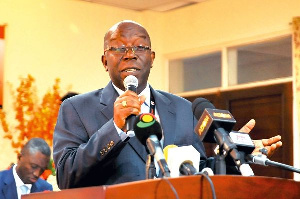- Home - News
- Polls
- Year In Review
- News Archive
- Crime & Punishment
- Politics
- Regional
- Editorial
- Health
- Ghanaians Abroad
- Tabloid
- Africa
- Religion
- Election 2020
- Coronavirus
- Photo Archives
- News Headlines
- Press Release
General News of Saturday, 30 November 2019
Source: theheraldghana.com
NPRA directive will kill SSNIT in two years
The Social Security and National Insurance Trust (SSNIT), has strongly responded to accusation by the Forum for Public Sector Registered Pension Schemes and the threat to embark on a strike action by January 1, 2020, over the Trust’s noncompliance with a directive by the National Pension Regulatory Authority (NPRA) on past credits.
At a press conference, Thursday, aside a press release to respond to the forum, Director General of SSNIT, Dr. John Ofori-Tenkorang, said the directive by NPRA, was alien to the Pensions Act, 2008, Act 766.
He was emphatic SSNIT, cannot grant the wish of NPRA and by extension, the FORUM, because any attempt to do so will throw the Trust’s Past Credit liability out of gear in record time.
According to the SSNIT boss, the directive by the NPRA, if implemented will put the Scheme into financial crises in two years, as the fund ratio will drop threatening its sustainability.
The NPRA’s directive if carried out, will overturn what has already been lawfully determined by the bodies vested with the authority to do so, as per section 94 (1) (d) of Act 766, the SSNIT boss said, adding “this matter had already been closed and communicated to SSNIT by NPRA in their letter dated 9th September 2015, as I’ve already mentioned”.
Dr. Ofori–Tenkorang, said the NPRA decree, ignored the fact that the formula agreed for calculating the Past Credit as at December 31, 2009, was arrived at after several deliberations between SSNIT and NPRA, who were authorized by law to do so.
That formula, he said, includes the interest applicable to all members under PNDCL 247 and was in accordance with the Scheme rules and the Scheme funding principles applicable to all members under PNDCL 247.
“The details and analysis of the Past Credit were duly submitted to NPRA, including simulation figures of the Past Credit based on the formula for computation of the Past Credit up to 31st December 2009. NPRA in their letter (NPRA/SSNIT/14/28/15) to SSNIT dated 9th September 2015, stated that the Authority “Agrees of the Method/ Formula you proposed in your Report to the NPRA titled “Analysis of Past Credit Under Act 766”.
He charged, “The said directive also failed to provide any actuarial justification as required by law in determining the Past Credit”.
The Past Credit is the contribution of workers to SSNIT, before the coming into force of Act 766, which brought about the three-tier pension scheme. Act 766, gave birth to the three-tier pension scheme.
The Forum on Monday served notice that; members would embark on strike from January 1, 2020, in solidarity with their retirees, if SSNIT, fails to comply with NPRA on past credits.
According to the Forum, made up of about 14 public sector workers, they would stay at home in solidarity with the retired members, if SSNIT, continues with wrong computation for retirees to receive paltry past credits as pensions.
Chairman of the Forum, Isaac Bampoe Addo, said this at a media briefing in response to SSNIT’s assertion that, it has complied with the NPRA directives with regards to the past credit for the public sector retirees.
He said, SSNIT, had not adhered to the directive of the NPRA, which directed that all past credits as determined must earn interest at 91-day government Treasury bill rate prevailing at the time the contribution was received.
Isaac Bampoe Addo said “Regrettably, SSNIT has failed to comply with the NPRA directives on the Past Credits. What SSNIT stated in its press statements are false and this is a deliberate attempt to cheat the worker.”
He said, SSNIT, had received the NPRA directives in September 2019 and are aware that their current method of computation is way below the instructions given by the Regulator, NPRA.”
He described as “misleading” a statement issued by SSNIT to the effect that it has recomputed the Past Credits of members using 100percent Treasury Bill Rate compounded quarterly as captured in a previous agreement and that the result of that computation is shown on the Statement of Accounts of its members.
“SSNIT is aware that it used rates of 50% Treasury Bill Rate (and below) to calculate the Past Credits which was rejected by The Forum,” Mr Addo said, challenging SSNIT to reveal its current method of computing the Past Credits.
He added “The Forum observes that currently, most of the Public Sector Occupational Pension Schemes (Tier 2) are performing well and earning above the Treasury Bill Rate. It must also be noted that long term bonds issued by government are by far higher than the Treasury Bill Rate.
“In fact, all Tier 2 funds, including Past Credits, should be in the custody of custodians of various trusts. By agreeing to allow the Past Credits to remain with SSNIT on the grounds that immediate transfer of the funds will jeopardize the operations of SSNIT, we are making a lot of sacrifices and that should be recognized.”
But, Dr. John Ofori-Tenkorang stressed “let me emphasis that should this directive, which is not in accordance with Act 766 be implemented, the Trust’s Past Credit liability will increase to a whopping GHc 5.87 billion as at October 2019, representing an increase of GHc4.5 billion over what the liability was before the revision that was accepted in the communiqué was implemented.
The effect of this directive will put the whole SSNIT Scheme into financial crisis mode from 2022, as the fund ratio will drop from 3.1 to 0.3. This will affect the long-term sustainability of the Scheme”.
The Director-General, who hoped the latest press conference will bring more clarity and some finality to the issue said, the Board of SSNIT, has already met and thoroughly considered the “illegal directive” from NPRA and insists that the Trust will not be able to implement the directive in the regulator’s letter dated September 18, 2019, ostensibly because of several reasons which have already been communicated to NPRA.
“Subsequent to that communication, the SSNIT Board and the NPRA Board met on 19th November, 2019 (and by the way Labour is ably represented on both boards) to discuss the matter and the NPRA has requested SSNIT to produce an actuarial valuation of the Scheme by 3rd December, 2019 for their consideration”, he said.
The statement by Dr Ofori-Tenkorang said a Ministerial Committee was formed in September 2017, to resolve outstanding issues relating to funds TPFA 2 to the four public sector occupational pension schemes and one of the terms of reference for the Committee was to “discuss and make recommendations on the issue of Past Credit.”
The said communiqué was signed by the Minister of Finance, Ken Ofori-Atta and the Minister of Employment and Labour Relations, Ignatius Baffour Awuah on behalf of Government, Isaac Bampoe Addo and Dr. Justice Yankson, on behalf of the Forum.
“After the Ministerial Committee had completed its work, a communiqué dated 24th November 2017, (titled: Communiqué on the Report of the Ministerial Committee on outstanding issues relating to Tier-two Pension Funds for Public Sector Workers), which was signed by the Minister for Finance and the Minister for Employment and Labour relations on behalf of government and Mr. Isaac Bampoe Addo and Dr. Justice Yankson on behalf of the FORUM was issued.
According to him, there were workers affected by the Act 766 who as at 31st December 2009 (i.e. the eve of the implementation of the Act 766), had contributed to the Scheme, adding this meant that they had contributed 17.5 percent of their salaries to SSNIT which was more than the current 13.5 out of which 2.5 is forwarded to the National Health Insurance Authority.
“These salaries accumulated with interest from the dates on which the contributions were received by the Trust, up to 31st December 2008. This past credit plus additional accrued interest from 1st January 2010 till the date of retirement is what is paid to the member by SSNIT as part of their lump sum. The rest of the lump sum is paid by the private tier-2 fund managers.”
According to him, the proposed formula for the computation of the past credit as at 31st December 2009 dealt with two issues.
The issues, he said, included the percentage of annual salary that was to be used and the interest rate that should be applied to those contributions up to December 31, 2009.
Entertainment










